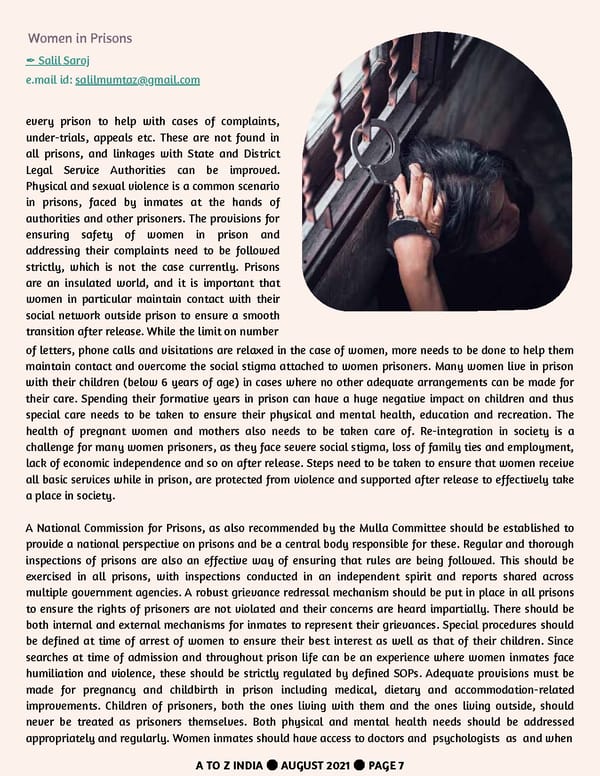Women in Prisons ✒ Salil Saroj e.mail id: [email protected] every prison to help with cases of complaints, under-trials, appeals etc. These are not found in all prisons, and linkages with State and District Legal Service Authorities can be improved. Physical and sexual violence is a common scenario in prisons, faced by inmates at the hands of authorities and other prisoners. The provisions for ensuring safety of women in prison and mplaints need to be followed addressing their co strictly, which is not the case currently. Prisons are an insulated world, and it is important that women in particular maintain contact with their social network outside prison to ensure a smooth transition after release. While the limit on number of letters, phone calls and visitations are relaxed in the case of women, more needs to be done to help them maintain contact and overcome the social stigma attached to women prisoners. Many women live in prison with their children (below 6 years of age) in cases where no other adequate arrangements can be made for their care. Spending their formative years in prison can have a huge negative impact on children and thus special care needs to be taken to ensure their physical and mental health, education and recreation. The health of pregnant women and mothers also needs to be taken care of. Re-integration in society is a challenge for many women prisoners, as they face severe social stigma, loss of family ties and employment, lack of economic independence and so on after release. Steps need to be taken to ensure that women receive all basic services while in prison, are protected from violence and supported after release to effectively take a place in society. A National Commission for Prisons, as also recommended by the Mulla Committee should be established to provide a national perspective on prisons and be a central body responsible for these. Regular and thorough inspections of prisons are also an effective way of ensuring that rules are being followed. This should be exercised in all prisons, with inspections conducted in an independent spirit and reports shared across multiple government agencies. A robust grievance redressal mechanism should be put in place in all prisons to ensure the rights of prisoners are not violated and their concerns are heard impartially. There should be both internal and external mechanisms for inmates to represent their grievances. Special procedures should be defined at time of arrest of women to ensure their best interest as well as that of their children. Since searches at time of admission and throughout prison life can be an experience where women inmates face humiliation and violence, these should be strictly regulated by defined SOPs. Adequate provisions must be made for pregnancy and childbirth in prison including medical, dietary and accommodation-related improvements. Children of prisoners, both the ones living with them and the ones living outside, should never be treated as prisoners themselves. Both physical and mental health needs should be addressed appropriately and regularly. Women inmates should have access to doctors and psychologists as and when A TO Z INDIA ● AUGUST 2021 ● PAGE 7
 A TO Z INDIA - AUGUST 21 Page 6 Page 8
A TO Z INDIA - AUGUST 21 Page 6 Page 8